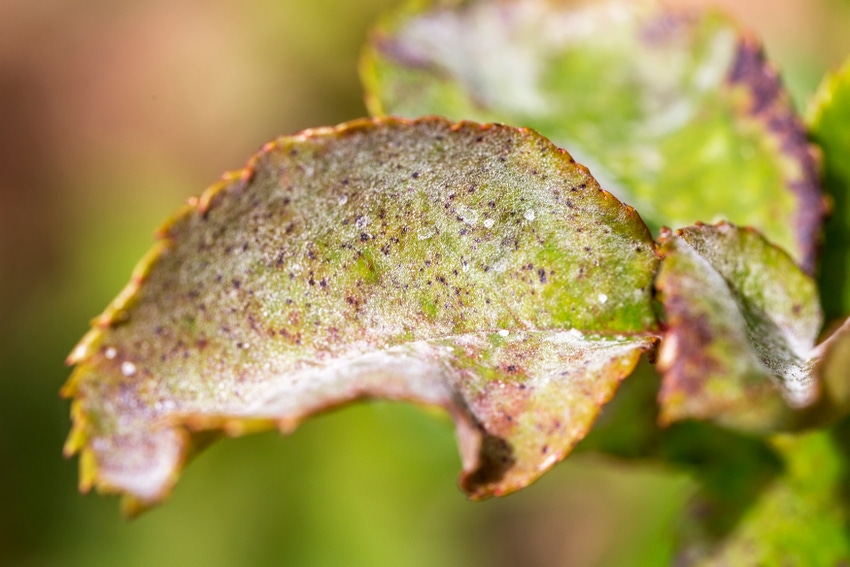
Unusually heavy powdery mildew pressure last year combined with drenching winter rains have set the stage for another season of increased risk of the disease for San Joaquin Valley growers. At the same time, some could see more botrytis infections than usual in their fields this year, says Allison Ferry-Abee, University of California Cooperative Extension area viticulture advisor, based in Tulare County.
While fungicides play a critical role in limiting outbreaks of these infections, botrytis is showing signs of resistance to some commonly used synthetic fungicides. Resistance is also possible in powdery mildew, she notes.
“In the case of powdery mildew, there are fungicides which eradicate the fungus,” Ferry-Abee says. “But, fungicides are most effective in preventing infections from becoming established rather than trying to control them once they’ve spread.”
She advises using the UC-Davis powdery mildew risk index for timing fungicide applications. This tool relates the risk of the disease developing in the vineyard to air temperature and predicts the need to spray to protect the vines.
Ferry-Abee recommends beginning treatment at bud break. Spraying wine and raisin grapes should continue, as needed, until sugar levels in the fruit reach 12 ºBrix. The powdery mildew fungus won’t infect the grape berries at higher sugar content. Although the rachis remains vulnerable to the disease as the grapes continue to ripen, such infections don’t affect the marketability of wine and raisin grapes.
It’s a different story with table grapes. In this case, rachis infections adversely affect the appearance of the bunches, reducing their market value, Ferry-Abee notes. That’s why she advises continuing to treat table grapes with preventive fungicide applications, as needed, until harvest, while observing any required pre-harvest interval between treatment and harvest.
Rain this spring could encourage an increased incidence of shoot blight – patches of soft brown tissue that kill the infected plant part – due to botrytis. Growth of fungal spores that spread the disease by air currents or splashing rain is triggered by free moisture that remains on the surface of the shoots for a period of time. Warmer temperatures encourage faster development of the disease.
If botrytis is a threat, Ferry-Abee recommends applying a fungicide at bloom. The fungal spores can get into the flowers and developing fruit to cause dormant infections even though symptoms of the disease may not appear until veraison.
“But keep in mind that the fungicides used to control powdery mildew can also control botrytis. So, with proper timing you can treat your vineyard to protect against both diseases with the same spray.”
Another critical time to treat for botrytis is right before bunch closure. That’s when it’s still possible to get good spray coverage of all the berries, which become very susceptible to the disease at veraison, Ferry-Abee notes.
At that point infected berries in a cluster turn brown on white cultivars or reddish in red and black cultivars. With moderate temperatures, high moisture levels and low winds epidermal cracks will form in which fungal growth produces mycelium and spores. This results in the characteristic gray, velvety appearance of infected berries.
Table grapes should also be treated as close to harvest as possible to help protect the fruit during storage, she adds.
Spores from infected fruit can directly infect intact, ripe berries as harvest approaches. Late-season infections are most severe when relative humidity exceeds 92 percent, free moisture is present on the fruit surface, and temperatures are in the 58° to 82°F range. Berries that have been damaged by insects, birds, machinery or other causes may become infected at any time after the fruit begins to ripen because the juice in the berry can provide the necessary water and nutrients for fungal growth.
A USDA scientist, Chang-Lin Xiao, based at the San Joaquin Valley Agricultural Sciences Center in Parlier, Calif., is studying the development of resistance of Botrytis isolates in the San Joaquin Valley to various synthetic fungicides. Of the isolates he studied, 93 percent were resistant to Pyraclostrobin; 80 percent were resistant to boscalid; 19 percent were resistant to cyprodinil; 7 percent were resistant to fenhexamid; and 1 percent were resistant to fluopyram. None were resistant to fludioxonil.
“These findings highlight the importance of treating for botrytis using fungicides with low rates of disease resistance,” Ferry-Abee says. “Also, since disease spores don’t become resistant to sulfur, including it in a tank mix with your powdery mildew or botrytis synthetic fungicide whenever possible will help slow development of disease resistance.”
More information on botrytis and powdery mildew is available at http://ipm.ucanr.edu
About the Author(s)
You May Also Like




